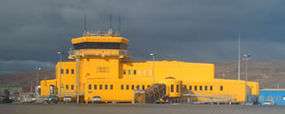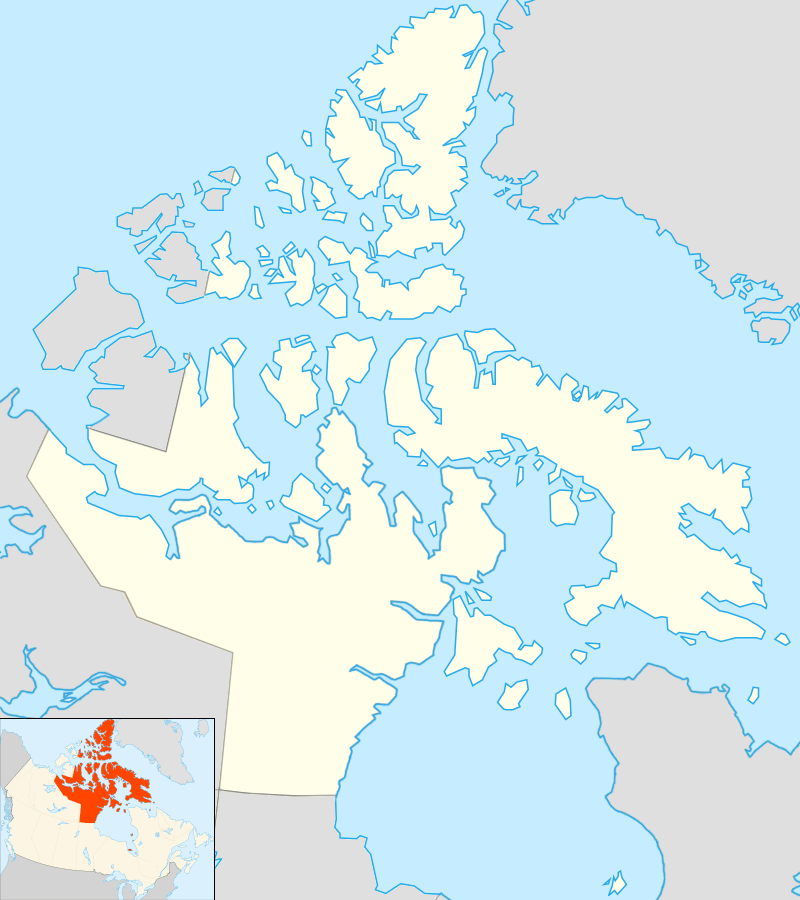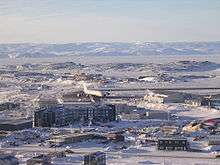Iqaluit Airport
| Iqaluit Airport | |||||||||||
|---|---|---|---|---|---|---|---|---|---|---|---|
 | |||||||||||
|
IATA: YFB – ICAO: CYFB – WMO: 71909 | |||||||||||
| Summary | |||||||||||
| Airport type | Public | ||||||||||
| Owner | Government of Nunavut[1] | ||||||||||
| Operator | Nunavut Airport Services Ltd. | ||||||||||
| Location | Iqaluit, Nunavut | ||||||||||
| Hub for | |||||||||||
| Time zone | EST (UTC−05:00) | ||||||||||
| • Summer (DST) | EDT (UTC−04:00) | ||||||||||
| Elevation AMSL | 110 ft / 34 m | ||||||||||
| Coordinates | 63°45′24″N 068°33′22″W / 63.75667°N 68.55611°WCoordinates: 63°45′24″N 068°33′22″W / 63.75667°N 68.55611°W | ||||||||||
| Map | |||||||||||
 CYFB | |||||||||||
| Runways | |||||||||||
| |||||||||||
| Statistics (2011/2010) | |||||||||||
| |||||||||||
Iqaluit Airport (IATA: YFB, ICAO: CYFB) serves Iqaluit, Nunavut, Canada and is located adjacent to the town. It is operated by the government of Nunavut. It hosts scheduled passenger service from Ottawa, Montreal, Rankin Inlet and Kuujjuaq on carriers such as First Air and Canadian North, and from smaller communities throughout eastern Nunavut. It is also used as a forward operating base by the CF-18 Hornet. In 2011, the terminal handled more than 120,000 passengers.[5]
The airport is classified as an airport of entry by Nav Canada and is staffed by the Canada Border Services Agency (CBSA). CBSA officers at this airport can handle general aviation aircraft only, with no more than 15 passengers.[2]
The airport serves as a diversion airport on Polar routes.[6][7]
The airport is owned by the Government of Nunavut[1] and operated, under a 30-year contract, by Nunavut Airport Services. The company is a subsidiary of Winnipeg Airport Services Corporation, which is in turn a subsidiary of Winnipeg Airports Authority.[8]
History
Military use
Iqaluit Airport was founded as Frobisher Bay Air Base in 1942 by the United States Air Force. Throughout the 1940s and 1950s the base was used by the United States and Canada for transportation purposes. The base was closed in 1963 and converted into a civilian airport.
Civilian use
Since the 1950s, Frobisher Bay had earned a reputation as a technical stop for airlines flying the North Atlantic. Crews departing westward from Prestwick or Shannon in those years preferred to route via Iceland (or the Azores) to Gander, thence to New York City or elsewhere. Weather, however, could dictate a northerly course, which is when Frobisher Bay came into its own. At one time, Pan American even had a base there and on at least two occasions had to change engines on Douglas DC-7Cs at Frobisher Bay.
With the introduction of the intercontinental Boeing 707 and Douglas DC-8, fewer airlines stopped at Iqaluit. Even so, there always seemed to be some activity. The place remained prominent as a regional airport, continued in its strategic role of sustaining the Distant Early Warning Line (DEW), supported the occasional military exercise or scientific expedition, and was still a key stopover on the North Atlantic ferry route.
Through the 1960s, Nordair was the main airline serving Frobisher Bay from Montreal, 1,100 nautical miles (2,000 km; 1,300 mi) to the south. Douglas DC-4s operated into the 1970s and Lockheed Super Constellations between 1964 and 1969. In 1968 Nordair introduced the Boeing 737-200 on the Frobisher Bay run. At the same time, Bradley Air Services had been expanding. By the 1970s, the company's fleet of de Havilland Canada DHC-6 Twin Otters and Douglas DC-3s was serving many small Arctic communities from YFB, carrying passengers, mail, groceries, and other essentials. Bradley became known as First Air in 1973 and soon added BAe 748s.
In the 1980s, Canada's airline industry was in transition, with Air Canada and Canadian Airlines rapidly buying up regional operators. Air Canada acquired Nordair in 1977, and then sold it in 1984 to Canadian Airlines. Jet service to Iqaluit Airport continued, but under the Canadian North banner, which was, after the buyout of Canadian Airlines by Air Canada, to continue operations as an independent airline, jointly owned by the Inuit of the Northwest Territories and Nunavut. Between 1985 and 1988 First Air added four Boeing 727s to link Montreal and Ottawa with Iqaluit. Meanwhile, Canadian Airlines failed, and was taken over by Air Canada in 2000. In 1995 First Air purchased the small Yellowknife-based carrier Ptarmigan Airways; then, in 1997, Northwest Territorial Airways (NWT Air), Air Canada's Yellowknife subsidiary. In the NWT Air move First Air acquired two 737-200 Combis and a Lockheed 382 Hercules.[9]
Facilities
- 2 hangar/cargo terminals (First Air/Canadian North)
- 1 two-storey terminal building
- 1 main runway
- three aprons
- 1 FBO (Frobisher Bay Touchdown Services)
Iqaluit International Airport Fire Department operates one crash tender for local fire suppression and has support from Iqaluit Fire Department when needed.
Terminal
The main terminal has:
- Check-in desks
- 3 gates
- 1 baggage claim belt
- Gift shop
- Travel agent
- Tourist help desk
- Car rental
- Taxi service/rank
- Baby/parent room
- Disabled access/facilities
There are 30 short term parking spaces at the airport.
Future development
As a result of increased traffic, the Nunavut government is planning an overhaul of the airport which is expected to cost between $250 and $300 million. The project will be a public–private partnership with the GN borrowing their half of the cost. Nunavut Airport Services will operate the airport for 30 years. Upgrades will include:
- new 100,000 sq ft (9,300 m2) terminal building constructed by Bouygues[10]
- retrofitting the current terminal which will become solely an administration building and control tower
- expanding parking lots
- new combined services building to house all airport and safety vehicles
- a second taxiway
- apron and repaving the runway.
The construction began in 2014 and is expected to be completed by 2017.[11][12]
On September 5, 2015, during construction, a large fire caused major damage to the roof of the new terminal, resulting in $1 million in damage.[13]
Other information
Several flights have been diverted to Iqaluit Airport due to passenger medical emergencies. On 5 October 2015, a passenger on board a flight from Moscow to Los Angeles suffered a heart attack, necessitating an emergency landing in Iqaluit.[14] On 31 May 1996, Virgin Atlantic flight 7 from London to Los Angeles made an emergency landing at Iqaluit after a passenger had a heart attack. The landing was executed safely - the first Boeing 747 ever to attempt to land at Iqaluit - but one of the 747's engines hit a fuel pump on the tarmac as it was taxiing, causing serious damage to the aircraft and a potentially dangerous fuel spill. The 397 stranded passengers, including singer Gary Barlow, were flown out after Virgin Atlantic chartered two jets. The passengers, after spending 16 hours in a local curling rink, were taken to New York to catch connecting flights to Los Angeles. Prince Michael of Kent, who had also been on the flight, was given a Royal Canadian Mounted Police escort and departed on an earlier scheduled flight. The original aircraft had its engines repaired and left four days after the accident. The heart-attack victim survived.[15]
There is a persistent but false rumour that Iqaluit Airport was one of the emergency landing sites for NASA's Space Shuttle, due to the length of its runway and its geographic location.[16] This can easily be disproved by noting that Iqaluit's runway is less than 9,000 ft (2,743 m) long.

The Airbus A380, the world's largest passenger jet, conducted cold weather testing from Iqaluit Airport during February 2006 - its first North American visit. They were hoping to experience −25 °C (−13 °F) weather to determine the effects on cabin temperatures and engine performance. Nunavut authorities hope that the importance of these tests will put Iqaluit on the map as a centre for cold-weather testing.[17] In February 2013, Airbus Military used the airport to test the Airbus A400M Atlas military transport aircraft that is currently being developed.[18] The city government sent a delegation to Paris Airshow in June 2013 to promote Iqaluit as an ideal location for these tests. Airbus A350 followed suit and conducted its cold weather testing in January 2014. Airport staff cited low landing fee, sufficient runway length, and minimal air traffic movement all helped in the decision making.[19]
In December 2005 the Government of Nunavut announced that it would spend $40 million to repair the runway, build a new emergency services facility and a new terminal.[20]
In January 2012 Air Greenland announced that a 1-hour, 45-minute flight from Nuuk to Iqaluit, down from three days when going via Copenhagen or Reykjavik and then on to Ottawa, would begin 18 June 2012, later changed to 15 June. The service was a partnership with First Air who provided ticketing and other services in Iqaluit. This was the first international flight into Iqaluit since 2001 when First Air discontinued its Iqaluit to Kangerlussuaq flights. Air Greenland used Dash 8 aircraft on the run.[21][22][23][24] After three years in place the service was discontinued for the 2015 season.[25]
Airlines and destinations
Cargo Airlines
| Airlines | Destinations |
|---|---|
| Canadian North | Ottawa |
| Cargojet Airways | Winnipeg |
| First Air operated by Cargojet Airways | Kuujjuaq, Montreal-Trudeau |
| Purolator Courier operated by Cargojet Airways | Calgary |
Accidents and incidents
- On 12 February 1973, Douglas C-47A C-FOOV of Kenting Atlas Aviation crashed on approach. The aircraft was on a ferry flight to Resolute Bay Airport when power was lost shortly after take-off from Iqaluit and the decision was made to return. All three people on board survived.[27]
- On 14 August 1996, a Canadian Forces CF-18 Hornet left the runway during takeoff, slid down an embankment and ruptured a fuel pipeline. The aircraft caught fire, as did fuel spilling from the pipeline, however the pilot had ejected just as the plane left the runway and suffered a broken ankle. The pipeline was shut down and the fire brought under control in less than an hour.[28]
- Over the years several flights have been diverted to Iqaluit due to on-board medical emergencies with no deaths being reported.
References
- 1 2 Airport Divestiture Status Report
- 1 2 Canada Flight Supplement. Effective 0901Z 15 September 2016 to 0901Z 10 November 2016
- ↑ Synoptic/Metstat Station Information
- ↑ Total aircraft movements by class of operation — NAV CANADA flight service stations
- ↑
- ↑ Boeing-conducted Airport safety and operational assessments
- ↑ New Cross-Polar Routes
- ↑ Winnipeg Airport Services Corporation
- ↑ Airways (June 2006) Pages 24-28 YFB and First Air
- ↑ 2015 Registration Document page 36
- ↑ "Iqaluit airport to be overhauled by 2017". CBC. 2012-07-06.
- ↑ "New public-private Iqaluit airport to cost up to $300 million". Nunatsiaq News. 2012-07-06.
- ↑ "Iqaluit airport terminal fire damage estimated at $1M". CBC. 2015-09-10.
- ↑ "Moscow to L.A. flight makes emergency landing in Iqaluit". CBC. 2015-10-05. Retrieved 2015-10-06.
- ↑ Unexpected Arctic stop for Brits, Yanks
- ↑ List of Space Shuttle emergency landing sites at GlobalSecurity.org
- ↑ "Jumbo Airbus getting cold, and more, during Iqaluit tests". CBC. 2006-02-10. Retrieved 2010-04-12.
- ↑ Airbus Military A400M undergoes latest cold weather tests
- ↑ "Airbus's new A350 in Iqaluit for cold weather testing". CBC News. 2014-01-27.
- ↑ Nunatsiaq News
- ↑ "Air Greenland teams with First Air for Iqaluit flights". 8 June 2012.
- ↑ "Air Greenland opens summer-route to Canada". Air Greenland. 18 January 2012.
- ↑ Iqaluit-Nuuk service ready for June 15 take-off
- ↑ Tireless lobbying led to Iqaluit-Greenland air link revival
- ↑ "Air Greenland cuts Nuuk-Iqaluit scheduled flights in 2015". CBC News. 6 March 2015.
- ↑ Flight Schedule and Route Map.
- ↑ "CF-OOV Accident description". Aviation Safety Network. Retrieved 26 August 2010.
- ↑ Pilot ejects in nick of time as CF-18 crashes while attempting to take off.
External links
| Wikimedia Commons has media related to Iqaluit Airport. |
- Past three hours METARs, SPECI and current TAFs for Iqaluit Airport from Nav Canada as available.
- Website of local private pilot group based at CYFB